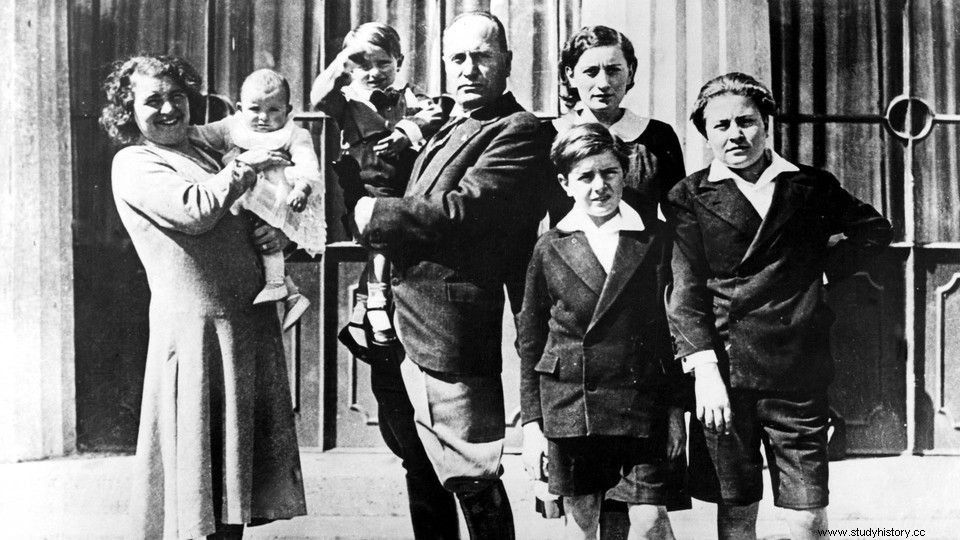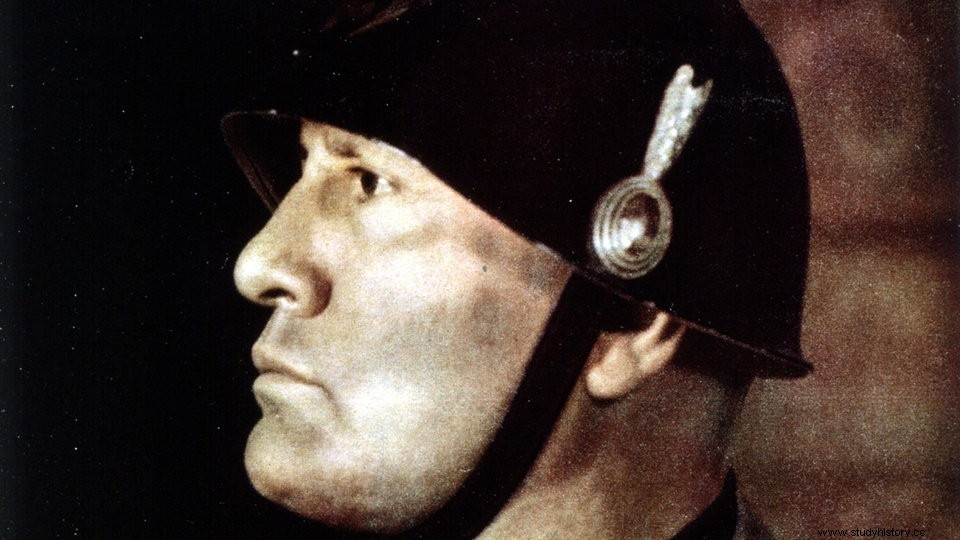He seduced the masses, staged the cult surrounding his person and made fascism socially acceptable in Italy:Benito Mussolini, the former "Duce" of the Italians. From 1922 to 1945 the dictator ruled over the country south of the Alps.
Mussolini was a master of political agitation, filled with imperial dreams of becoming a great power and the great role model of the man who seized power in Germany in 1933:Adolf Hitler. Benito Mussolini is still a myth for some Italians today:every year several thousand followers make a pilgrimage to his tomb.
Rebellious Youth
Benito Mussolini was born in 1883 in the small village of Predappio in Emilia Romagna. His mother Rosa was an ambitious elementary school teacher, to whom Mussolini owed his education at a Catholic boarding school. The father Alessandro worked as a blacksmith. Actually, for the conditions at that time in Italy, which was shattered by chaos and economic problems, it was a solid parental home.
But even the young Mussolini was a rebel. He had difficulty submitting to authority and accepting societal rules. That is why he gave up his middle-class job as a teacher early on and fled to Switzerland in 1902. There and later in Trento, which belongs to Austria, he led an unsteady life.
Mussolini tested his talent as a political agitator and developed a keen interest in political theory. But he subscribed to no ideology. He changed his political beliefs as soon as it seemed useful to him. In 1909 Mussolini returned to Italy and initially worked as a political journalist. Six years later he married his wife Rachele, with whom he had five children.

Mussolini with his wife Rachele and their five children, 1932
The March on Rome
Mussolini was badly injured in World War I, but quickly returned to the political arena after recovering. He skillfully ran the founding of a new, the "fascist" movement. On March 23, 1919, he founded the "Fascist Combat Alliance" in Milan, also known as the "Black Shirts".
Former combatants, the politically homeless and, above all, numerous sons of the northern Italian landowners gathered in these combat troops. They shared the longing for a violent, politically not clearly defined activism. Bloody street terror soon reigned in the northern Italian cities. The fascists acted particularly harshly against socialists, communists and the Slavic minority.
But Mussolini was not able to take power in Italy with the fighting alliances alone – the fear of a revolution was too deep-seated among those in power in the government of Giovanni Giolitti and his successor Ivanoe Bonomis. Mussolini therefore worked feverishly on a plan:He transformed the fascist movement into the legal "Partito Nazionale Fascista" (PNF), which primarily pursued military activism.
This new party reported to the "Duce" (leader) himself and was officially elected to the Italian Parliament in the new elections of May 15, 1921. Mussolini's double strategy, on the one hand taking advantage of the threatening potential of the violent fascists and on the other hand taking power with a legal party, worked.
When Bonomi's government fell in February 1922, Mussolini took advantage of the situation and increased the pressure through renewed violent actions by the fighting groups on Italy's streets. He demanded that power be transferred to the fascists, which he finally succeeded in doing.
On October 28, 1922, Mussolini and his followers marched on Rome. Fascism had swelled into a mass movement. King Vittorio Emanuele III. – Italy was a parliamentary monarchy – could no longer help himself and commissioned Mussolini to form a new government.
But despite Mussolini's threatening gestures, it was not a coup:the "Duce" only had his "blackshirts" march into Rome after the bourgeois parties and King Mussolini had secured the office of prime minister.
Just three years later, the "Duce" announced his personal dictatorship and gradually transformed Italy's political system into a totalitarian state by the end of the 1920s.

The March on Rome brought Mussolini the office of Prime Minister
Mussolini – Duce, Emperor and Commander
Mussolini used the whole range of propaganda to expand his rule. Italian fascism was a leader dictatorship tailored to Mussolini. With all means he promoted the cult around his person and developed fascism into a mass movement. In this movement, the individual counted for nothing, only the community counted.
Mussolini implemented this principle even with the youngest children. The children were sworn to the "Duce" at an early age in the fascist organization "L'Opera Nazionale Balilla". Hitler later imitated this principle with the Hitler Youth. Mass events such as military parades and major sporting events should promote approval among the population.

Standard bearer in the fascist youth organization "Balilla"
It was almost impossible to evade the presence of the "Duce":there were postcards with Mussolini's likeness everywhere, the traveling cinemas brought the dictator on the screen to the furthest corners of southern Italy and the newspapers did the rest.
Mussolini was everywhere. And that was also his claim when it came to expanding Italy's sphere of power. He wanted to build on the Roman Empire of antiquity and expand his empire across the Mediterranean to the Indian Ocean.
In 1934 Mussolini declared Libya an Italian colony, a year later he attacked what is now Ethiopia, took part in the Spanish Civil War on the side of Franco and finally entered World War II on the side of Germany in 1940.

Benito Mussolini 1940
Downfall of a dictator
In the early 1940s, fascism slowly came under criticism from Mussolini's compatriots as well. Italy was exhausted by the constant wars. It was slowly dawning on many that Italian fascism offered no solutions to the country's immense problems.
When Mussolini then led the campaign against Greece on his own in 1940, the embarrassment was complete. Hitler's army had to intervene to avert the Italian surrender in Greece. Defeat followed defeat, finally sealing the political fate of the "Duce" in July 1943.
When Allied troops landed in Sicily on July 9, 1943, the Fascist Grand Council, the constituent body of fascism, deposed Mussolini. He was arrested and finally imprisoned on the "Gran Sasso" mountain range in Abruzzo.
But Mussolini's "new" enemies had reckoned without Hitler:he had his ally liberated in a spectacular action and at the same time northern Italy occupied by German troops. He installed Mussolini as leader of the German-occupied areas of Italy, also known as the "Puppet Republic of Salò".

This is where Mussolini was imprisoned in 1943
Two years later, when the surrender of the Germans could no longer be averted, the "Duce" tried to flee to Switzerland with his lover Claretta Petacci. But he was caught by Italian resistance fighters on April 27, 1945 and shot together with his lover.
